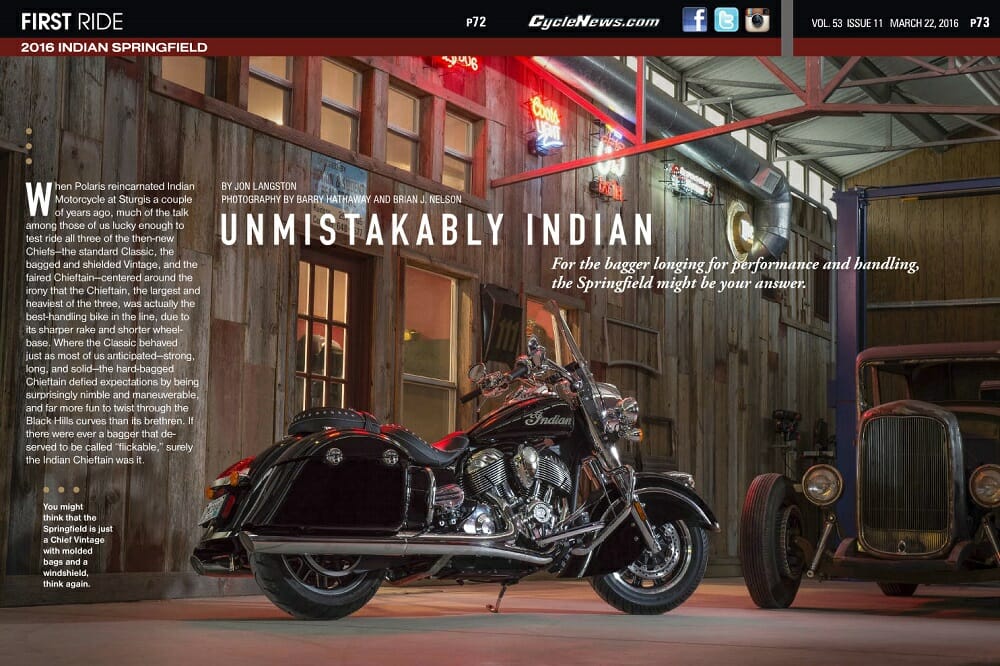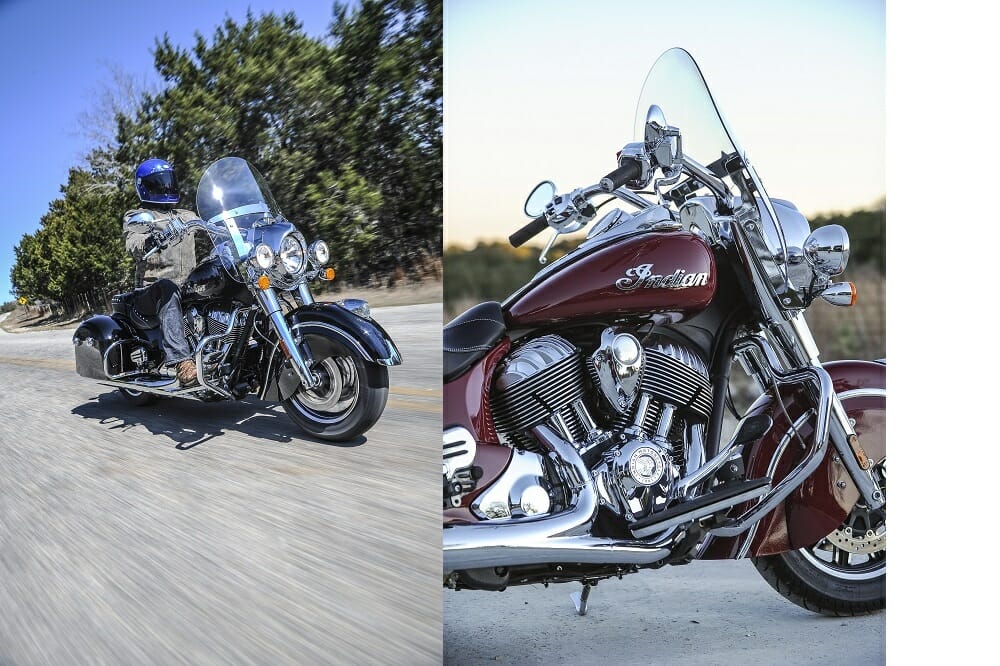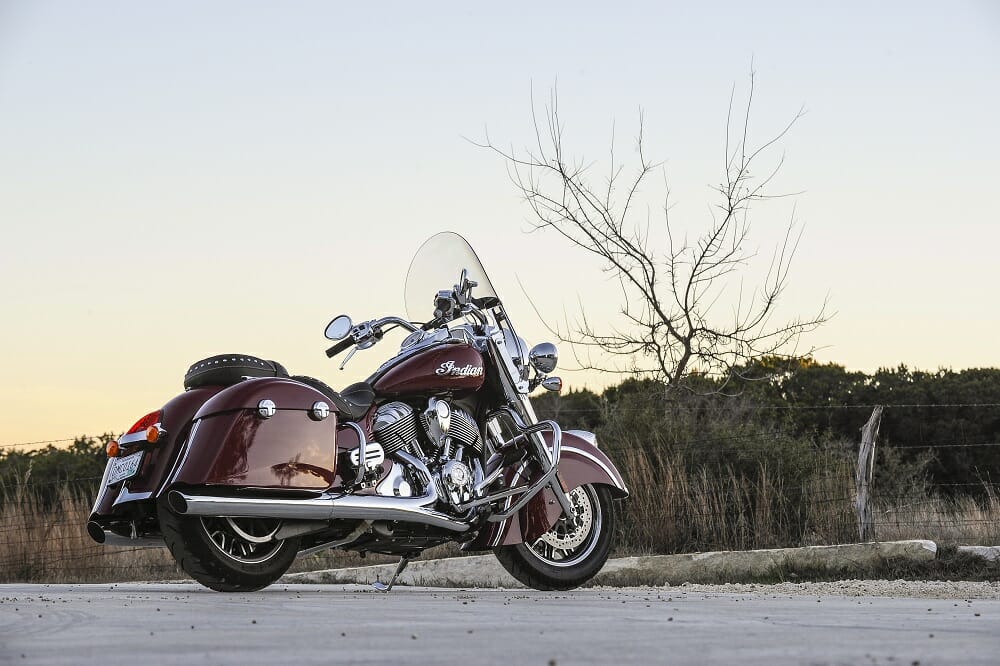| March 24, 2016
 You might think that the Springfield is just a Chief Vintage with molded bags and a windshield, think again.
You might think that the Springfield is just a Chief Vintage with molded bags and a windshield, think again.
For the bagger rider longing for performance and handling, the Springfield might be your answer.
By Jon Langston, Photography by Barry Hathaway and Brian J Nelson
When Polaris reincarnated Indian Motorcycle at Sturgis a couple of years ago, much of the talk among those of us lucky enough to test ride all three of the then-new Chiefs—the standard Classic, the bagged and shielded Vintage, and the faired Chieftain—centered around the irony that the Chieftain, the largest and heaviest of the three, was actually the best-handling bike in the line, due to its sharper rake and shorter wheelbase. Where the Classic behaved just as most of us anticipated—strong, long, and solid—the hard-bagged Chieftain defied expectations by being surprisingly nimble and maneuverable, and far more fun to twist through the Black Hills curves than its brethren. If there were ever a bagger that deserved to be called “flickable,” surely the Indian Chieftain was it.
 You can read the original magazine story by clicking HERE.
You can read the original magazine story by clicking HERE.
Last year, the Indian Motorcycle product line expanded to include the explosive, liquid-cooled Scout, and the massive, full-dressed Roadmaster, a touring machine created essentially by adding a top case and fairing lowers to the Chieftain. Borrowing that platform was a sage move by Indian, because the Roadmaster also received the Chieftain’s fine steering geometry—translating to a tighter turning radius and more maneuverability than either the Classic or Vintage. That’s right: despite the added weight out back, Indian’s full dresser is noticeably more nimble than its (relatively, for Indian) unadorned cruisers.
Which leads us to the new 2016 Indian Springfield, a bagger with hard-shelled, color-matched saddlebags and a windshield. If you’re thinking it’s clearly designed to compete with Harley-Davidson’s Road King, you’re right; if you’re thinking it’s nothing more than the Chief Vintage with molded hard bags instead of soft leather ones, you couldn’t be more wrong.
Well okay, you could, and hopefully you’ll forgive that bit of hyperbole. Fact is, the new Springfield looks unmistakably Indian and rolls on the same basic platform as the legendary marque’s other Big Twin offerings: nostalgic styling with plenty of chrome (must love fender skirts!), standard creature comforts such as keyless ignition, ABS, and electronic cruise control; 16-inch Dunlop Elites (130 up front and 180 out back); and of course, that seemingly bottomless Thunder Stroke 111 V-Twin powerplant. To call it a “brand-new model” might be still more exaggeration, but here’s the bottom line: the Springfield succeeds on its own merits by borrowing features of Indian’s established models and incorporating them into a touring bagger with signature style and exceptional handling.
 The new Springfield is remarkably agile for an 815-pound, nearly eight-and-a-half-foot-long cruiser.
The new Springfield is remarkably agile for an 815-pound, nearly eight-and-a-half-foot-long cruiser.
The capacious, remote-lockable hard bags are direct from the Chieftain and Roadmaster, and they snap off in seconds with simple, sturdy clamps to reveal sleek rear-fender skirts. To accommodate a passenger as well as the optional top case (the same integrated trunk that’s standard on the Roadmaster and available for the Chieftain) the rear suspension has been beefed up to accommodate 533 pounds, its air-adjustable shock boosted to 4.5 inches of travel (from the 3.8 found on the Classic and Vintage). Other touring amenities include front and rear highway bars, adjustable passenger floorboards, and, like the Roadmaster, Chieftain, and recently revealed Dark Horse, the Springfield rocks cast wheels, allowing for electronic tire-pressure monitoring via the LCD display in the dash-mounted speedo console.

The quick-detach windshield is exclusive to this model, its horizontal chrome-mounting strip narrower and less obtrusive than the one found on the Vintage’s shield. Two clips, and it’s off in seconds. The tank badge is larger than on the other models. Also exclusive is the real leather seat’s design and stitch pattern, although the saddle is similarly shaped and appears to be dimensionally identical; additionally, the Springfield’s 26-inch unladen seat height is the same, save for the Roadmaster. (It should be noted that, like the other Indians, the formed saddle puts the rider in a predetermined position and its sharp scoop discourages rider movement.) The removable passenger pillion is standard. Finally, the internally wired “buck horn” handlebar is specific to the Springfield, its grip location bringing the rider’s hands in and closer to the body for long-distance comfort.
Fine attributes all, but none of these is as intrinsic to the Springfield as its steering geometry. Boasting the same 25-degree rake angle and 65.7-inch wheelbase as the faired Chieftain and Roadmaster (four degrees sharper and 2.8 inches shorter, respectively, than the Classic and Vintage), the new Springfield is remarkably agile for an 815-pound, nearly eight-and-a-half-foot-long cruiser. Whereas the longer Indians can feel cumbersome at low speeds, the Springfield turns easily in and around parking lots. Figure in the 133mm trail (17mm less than the Chieftain) and subtract the weight of a fairing, and it feels even more maneuverable than the faired Indians. This bagger dives into corners with surprisingly little effort, and clever riders will utilize every foot-pound of torque the Thunder Stroke 111 has to offer to stand the Springfield upright.
 (Left) The Springfield chassis is a significant improvement for the Vintage. (Right) The Springfield’s quick-release windscreen is unique to the Indian line.
(Left) The Springfield chassis is a significant improvement for the Vintage. (Right) The Springfield’s quick-release windscreen is unique to the Indian line.
With plenty of torque for quick acceleration and high-speed passes, the Springfield is strong and confident on the highway; with its well-balanced suspension, responsive brakes, and that fine maneuverability, this bagger is just as eager to take on the twisties and head into the hills. By way of comparison, Indian provided a Vintage for us to ride at the press junket, and the difference was, frankly, astonishing. Truth be told, the Springfield’s chassis performs so much better than the Vintage’s that more than a few of the journalists assembled at its reveal were only half-joking when they (okay, we) pondered how long before Indian ditches the longer wheelbase platform altogether.
If there’s a personal nitpick besides the predetermined seating position, it’s the amount of glare all that chrome—on the dash, the triple tree, the colossal headlight bucket, just everywhere—throws back up at the rider on a bright day. And by reflecting the reflections, the windshield quite literally magnifies the effect. But this effect is nothing new to most riders, nor is it exclusive to this bike. Consider yourself forewarned.
 There is no shortage of chrome.
There is no shortage of chrome.
The Springfield is a touring-ready bagger that can take its rider—and passenger, and all their stuff—pretty much anywhere they want to go, comfortably, swiftly, and in style. For day cruises where wind protection and luggage aren’t necessary, pop off the windshield and snap off the saddlebags and you’ve got a sleek cruiser with ample power and phenomenal handling. An on-sale date has yet to be determined, but Springfields dressed in Indian Red and gloss black will hit dealerships with a $21,499 price tag; numerous accessories, including taller and shorter windscreens, performance and exhaust upgrades, comfort and styling options, etc., will be available shortly thereafter.
 The new Springfield will have an MSRP of $21,499.
The new Springfield will have an MSRP of $21,499.
For the bagger rider who longs for performance and handling but who loathes or is just plain over the whole retro scene, which the Chieftain and Roadmaster put front and center with their polarizing “streamliner” fairing, Indian has solved your quandary with its 2016 Springfield. For Road King fans looking to get a bit more from their American Big Twin bagger dollar, once again Indian Motorcycle has given the Motor Company ample reason to look over its shoulder.

You can read the original magazine story by clicking HERE.
For more Cycle News Cruiser motorcycle reviews, click HERE.
For more Indian motorcycle reviews, click HERE.